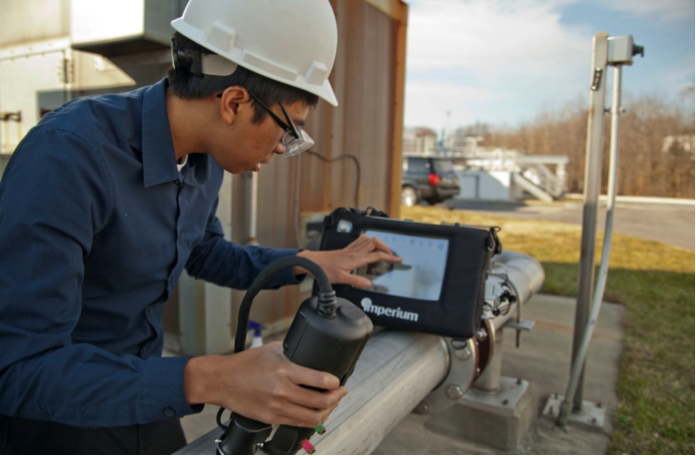Editor’s Note: This is another example of technological cross-sharing. This technology migrated from the aerospace industry. Use of this particular technology is already transferring to the process industries as the following trial cases illustrate.
Introduction
Technicians inspecting oil & gas installations and petrochemical plants employ a wide variety of nondestructive testing (NDT) techniques. A new technology has recently been developed that utilizes a real-time portable imaging device, known as the AcoustocamTM, which has distinct advantages in finding internal corrosion. The system, shown in Figure 1, allows minimally-trained technicians to scan areas of suspected internal corrosion from the exterior and produce C-scan images along with thickness readings. For this article, NDT inspectors in field trials tested this technology on steel pipes and storage tank bottoms to demonstrate its effectiveness in locating and quantifying subsurface corrosion.


The Corrosion Problem
Ensuring the integrity of pipelines and storage tanks is crucial. Unscheduled plant and pipeline shutdowns caused by corrosion costs U.S. oil & gas and petrochemical companies enormous sums of money annually in product losses, production downtime, and environmental cleanup efforts and fines. Accordingly, the industry invests heavily in inspection personnel and equipment to detect and monitor corrosion. In spite of these efforts, the National Society of Corrosion Engineers estimates that these costs can be reduced by up to 25 percent by implementing best practices and taking advantage of new technologies.
Traditional Solutions
When inspecting pipes and tanks, NDT technicians often use ultrasonic testing (UT) devices to detect and measure internal corrosion, pits and laminar indications such as blistering and delaminations. Traditional UT on steel structures can be tedious and prone to human error. Moreover, traditional point UT thickness readings merely quantify thinning at the point of the reading and are not comprehensive enough to find all areas affected by corrosion; yet more advanced techniques such as traditional Automated UT (AUT) are expensive and require extensive training.
AUT also has time-consuming, multi-step setup and analysis processes, often requiring both a skilled examiner and a highly-trained and experienced inspector when attempting to detect corrosion and other subsurface defects over large areas. Considering the shortage of qualified NDT inspectors and the length of down time required, the end result can often be high inspection costs.

















Comments and Discussion
Add a Comment
Please log in or register to participate in comments and discussions.